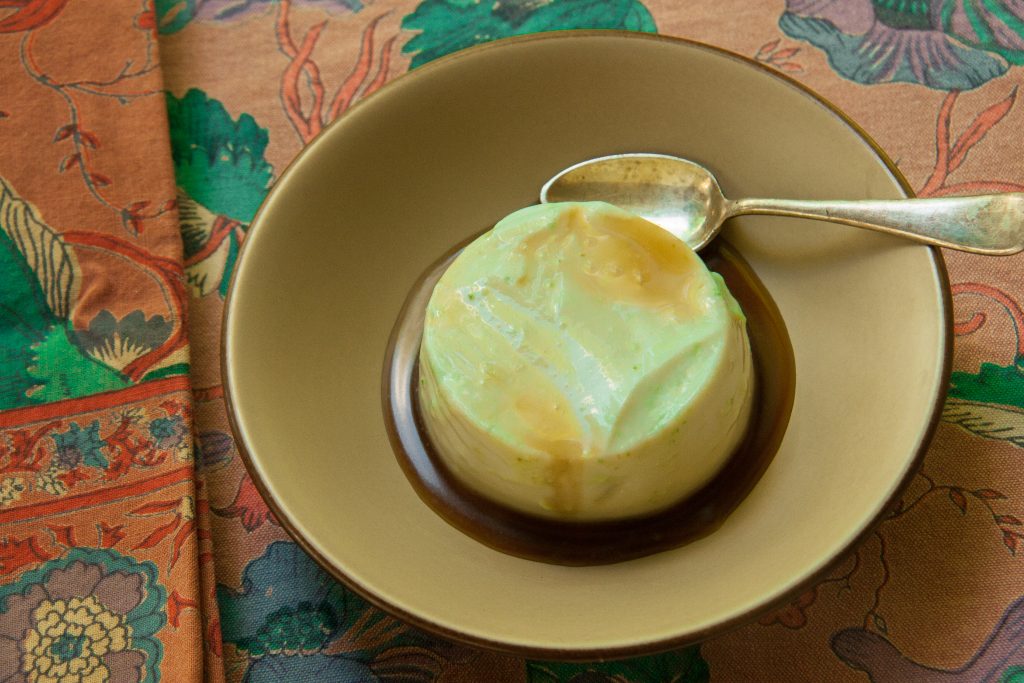
My dinner guests are often confused by this pale green dessert, and I can’t blame them. But I don’t tell them what they’re eating until AFTER they’ve tasted it. Why? I want people to experience these new, unbuyable flavors with an open mind, without any pre-conceived notions. After all, green is an unusual color for a dessert, and most people don’t think of evergreen trees as food plants. Not until after they’ve eaten spruce tip panna cotta.
This is a flexible recipe. You can make it with spruce tips, fir tips, or hemlock tips. (No, not poison hemlock! That’s a totally different plant, an herbaceous perennial as opposed to a woody conifer.) The tender tips of many evergreens are fresh and herbal, with a hint of citrus. Their color and flavor vary, and slightly older (but still flexible) needles have a stronger flavor.
What You’ll Need to Make Spruce Tip Panna Cotta
- 1 cup evergreen tips
- 2 cups heavy cream
- 1 cup whole milk
- 1/2 Tbs. unflavored gelatin powder
- 2 1/2 Tbs. sugar
- 1 Tbs. water
What You’ll Do to Make Spruce Tip Panna Cotta
Combine the spruce tips, milk, and cream in a blender, and use a low to medium speed to break up the needles. You don’t need to pulverize the spruce tips, but breaking up the needles increases their surface area and releases more flavor. I don’t use the high setting on my Vitamix because I’m afraid that might churn the cream into butter. I’ve never tested this theory, because I don’t want to waste perfectly good cream, but now that I think of it, ending up with spruce tip infused butter wouldn’t be the worst thing in the world. It just wouldn’t be dessert.
Refrigerate the cream/milk overnight, or for up to 24 hours.
The next day, strain the liquid, pressing on the needles to remove as much liquid as possible. You’ll probably want to do a second straining, or squeeze the cream through a jelly bag or cheesecloth to catch the little bits of tree. You should end up with about 2 cups of dairy.
Sprinkle the gelatin on top of the water to let the gelatin bloom. It will be ready by the time you need it.
Combine the strained cream/milk and sugar in a saucepan and bring it just to a simmer, then remove the pan from the heat. Whisk in the bloomed gelatin until it’s completely dissolved. Rub a little of the liquid between your fingers to make sure it’s silky, not grainy. If it’s grainy, keep whisking until the liquid is smooth.
As soon as the gelatin has fully dissolved, place the saucepan in an ice bath: a shallow pot or pan, filled halfway with a combination of ice cubes and water. Sit the bottom of the saucepan in the ice and whisk the cream until it’s lukewarm. You’ll know you’ve reached this point when the liquid feels neither warm nor cold against your finger. This is an essential step, without which the texture of your panna cotta will not be right.
Pour the lukewarm liquid into mini-canning jars or ramekins, and refrigerate until jiggly (4 hours or overnight). I use 4 oz. canning jars because each one has its own lid and I don’t have to use that infernal plastic wrap. I also have loads of canning jars and they’re cute. Dessert should appeal to both the eyes and the stomach, don’t you think?
Your spruce tip panna cotta can be served plain, or if you happen to have some brown sugar/spruce tip syrup in the back of your refrigerator, pour a drizzle of syrup onto each serving for an extra shot of flavor.
Feel free to play around with different edible evergreens (spruce, fir, and hemlock are all tasty; pine is meh; yew is toxic) and see which flavors please you most. And be prepared to field some questions from your pleasantly surprised dinner guests.

Your Spruce Tip Panna Cota looks amazing! What do you use as the sauce you have pictured in the photo?
That’s the brown sugar/spruce tip syrup I mention at the end of the post!
That is a really nice looking dessert.
Thanks very much, Debbie.